
Surfing is a surface water sport in which an individual, a surfer, uses a board to ride on the forward section, or face, of a moving wave of water, which usually carries the surfer towards the shore. Waves suitable for surfing are primarily found on ocean shores, but can also be found in standing waves in the open ocean, in lakes, in rivers in the form of a tidal bore, or in wave pools.

Smelts are a family of small fish, the Osmeridae, found in the North Atlantic and North Pacific Oceans, as well as rivers, streams and lakes in Europe, North America and Northeast Asia. They are also known as freshwater smelts or typical smelts to distinguish them from the related Argentinidae, Bathylagidae, and Retropinnidae.

Swansea is a former settlement and unincorporated community in Inyo County, California. It is located 8.5 miles (14 km) south of New York Butte, at an elevation of 3,661 ft (1,116 m).
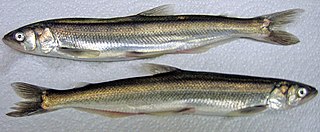
The eulacheon, also called the candlefish, is a small anadromous species of smelt that spawns in some of the major river systems along the Pacific coast of North America from northern California to Alaska.

Grunion are two fish species of the genus Leuresthes: the California grunion, L. tenuis, and the Gulf grunion, L. sardinas. They are sardine-sized teleost fishes of the New World silverside family Atherinopsidae, found only off the coast of California, USA, and Baja California, Mexico, where the species are found on both the Pacific Ocean and Gulf of California coasts. Many people enjoy catching grunion at events called "grunion runs."

The delta smelt is an endangered slender-bodied smelt, about 5 to 7 cm long, in the family Osmeridae. Endemic to the upper Sacramento-San Joaquin Estuary of California, it mainly inhabits the freshwater-saltwater mixing zone of the estuary, except during its spawning season, when it migrates upstream to fresh water following winter "first flush" flow events. It functions as an indicator species for the overall health of the Delta's ecosystem.

The rainbow smelt is a North American species of fish of the family Osmeridae. Walleye, trout, and other larger fish prey on these smelt. The rainbow smelt prefer juvenile ciscoes, zooplankton such as calanoid copepods, and other small organisms, but are aggressive and will eat almost any fish they find. They are anadromous spring spawners and prefer clean streams with light flow and light siltation. The rainbow smelt face several barriers. They are weak swimmers and struggle to navigate fish ladders preventing them from making it past dams to the headwater streams where they spawn. The rise in erosion and dams helped to decimate the smelt population in the 1980s. There are currently plans to try to reduce damming and to help control erosion.
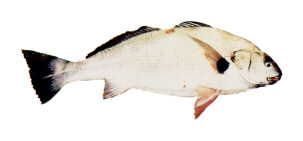
Spotfin croaker is a species of croaker occurring from Mazatlán, Mexico, to Point Conception, California, including the Gulf of California. It is the only species in the genus Roncador. In California, they are most commonly found south of Los Angeles Harbor. They live along beaches and in bays over bottoms varying from coarse sand to heavy mud and at depths varying from 4 to 50 feet or more. They prefer depressions and holes near shore.

The Sillaginidae, commonly known as the smelt-whitings, whitings, sillaginids, sand borers and sand-smelts, are a family of benthic coastal marine fish in the order Perciformes. The smelt-whitings inhabit a wide region covering much of the Indo-Pacific, from the west coast of Africa east to Japan and south to Australia. The family comprises only five genera and 35 species, of which a number are dubious, with the last major revision of the family in 1992 unable to confirm the validity of a number of species. They are elongated, slightly compressed fish, often light brown to silver in colour, with a variety of markings and patterns on their upper bodies. The Sillaginidae are not related to a number of fishes commonly called 'whiting' in the Northern Hemisphere, including the fish originally called whiting, Merlangius merlangus.
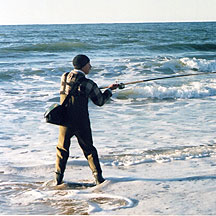
Surf fishing is land-based game fishing while standing on the shoreline or wading into the surf zone. A general term, surf fishing may or may not include casting a lure or bait, and refers to all types of shore fishing – from sandy and rocky beaches, rock jetties, or even fishing piers. The terms surfcasting or beachcasting refer more specifically to surf fishing from the beach by casting into the surf at or near the shoreline. With few exceptions, surf fishing is done in saltwater. The most common misconception about surf fishing is the idea that one must cast as far out as possible in order to reach the fish. At beaches on the west coast of the United States, and in fact, at most beaches around the world, you only really need to get your bait into knee-deep water. This is referred to as surf fishing the "skinny".

The oriental trumpeter whiting, Sillago aeolus, is a widely distributed species of benthic inshore fish in the smelt-whiting family. The species ranges from east Africa to Japan, inhabiting much if the southern Asian and Indonesian coastlines. Its morphology is very similar to other species within the genus Sillago, with a long, compressed body and silvery overall colour. It can be distinguished from its relatives by colour patterns and particularly swim bladder morphology, which helps define most species of Sillago. S aeolus is a benthic predator, consuming a variety of crustaceans and polychaetes. As with most members of the smelt whiting family, it is important to small coastal fisheries in various areas of its range.

The southern school whiting, Sillago bassensis, is a common species of coastal marine fish of the smelt-whiting family that inhabits the south and south-west coasts of Australia. Its distribution overlaps a number of other common sillaginids, with careful observation of anatomical features occasionally needed to distinguish between species. The southern school whiting is closely related to the eastern school whiting, Sillago flindersi, and initially were thought to be all one species. The species inhabits both shallow inshore sandy waters, as well as deeper offshore waters, with a transition of habitats occurring with increasing age. It is a predatory fish, taking a variety of crustaceans, polychaetes and bivalves as prey. It reaches sexual maturity at three years of age, and spawns multiple times between December and April. The southern school whiting is commonly caught by commercial and recreational fishermen, often while fishing for related species, especially the sought after King George whiting. The species is marketed fresh in southern Australia.
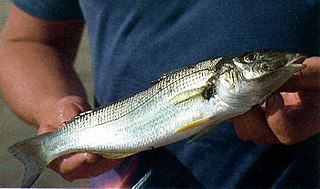
The sand whiting, also known as the summer whiting, yellowfin whiting or blue-nose whiting, is a common species of coastal marine fish of the family Sillaginidae, the smelt-whitings. It is a slender, slightly compressed fish that is very similar to other species of Sillago, with detailed spine, ray and lateral line scale counts needed to distinguish the species between its nearest relative Sillago analis. The sand whiting is distributed along the east coast of Australia from Cape York south to Tasmania, as well as Lord Howe Island and New Caledonia in the Pacific Ocean.
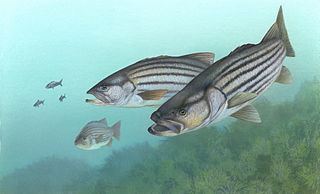
Striped bass are perciform fish found all along the Atlantic coast, from Florida to Nova Scotia. They are of significant value as sporting fish, and have been introduced to many areas outside their native range.
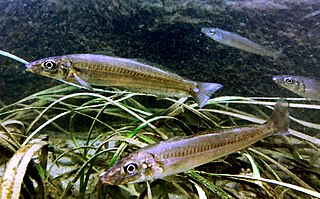
The Japanese whiting, Sillago japonica, is a common species of coastal marine fish belonging to the smelt-whiting family, Sillaginidae. As suggested by its name, the Japanese whiting was first recorded from Japan in 1843, but has subsequently been found to extend to Korea, China and Taiwan.

The San Francisco Estuary together with the Sacramento–San Joaquin River Delta represents a highly altered ecosystem. The region has been heavily re-engineered to accommodate the needs of water delivery, shipping, agriculture, and most recently, suburban development. These needs have wrought direct changes in the movement of water and the nature of the landscape, and indirect changes from the introduction of non-native species. New species have altered the architecture of the food web as surely as levees have altered the landscape of islands and channels that form the complex system known as the Delta.
This is a glossary of terms used in fisheries, fisheries management and fisheries science.

Stewarts Point State Marine Reserve (SMR) and Stewarts Point State Marine Conservation Area (SMCA) are two adjoining marine protected areas that extend offshore from about a mile south of Black Point to Fisk Mill Cove, in Sonoma County on California’s north central coast. The marine protected areas cover 25.22 square miles. Stewarts Point SMR prohibits the take of all living marine resources. Stewarts Point SMCA prohibits the take of all living marine resources, except recreational shore based take of marine aquatic plants, marine invertebrates, finfish by hook and line, surf smelt by beach net, and species authorized by Title 14 Section 28.80 by hand-held dip net.
Hypomesus pretiosus, or surf smelt, is a marine smelt with a range from Prince William Sound, Alaska to Long Beach, California, although its population declines south of San Francisco. The surf smelt grows to be about 10 inches in southern waters, and 83⁄4 inches in northern waters near Canada. On average, surf smelt weigh about 10 to the pound.
Stockport Creek is a 2.4-mile-long (3.9 km) tributary to the Hudson River in the town of Stockport, New York, in the United States. Its source is the confluence of Kinderhook Creek and Claverack Creek near the village of Stockport. Its mouth is at the Hudson River at the western boundary of Stockport. The creek is tidal for about one mile inland from the Hudson River.
















